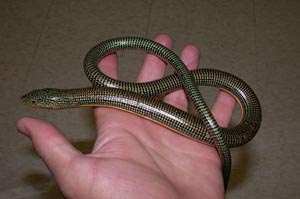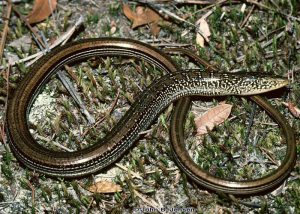
A legless lizard is a pretty weird phenomenon. I mean, isn’t a reptile without legs the very definition of a snake? Well, the locally found glass lizard is here to teach us why it’s not. For those steeped in reptile identification, there are several non-negotiable traits for snakes. They have no legs, no eyelids, and no ears. This is where the glass lizard comes in—while it is also legless, it does have eyelids and visible ear openings for external hearing. Interestingly, snakes detect sound through vibrations in their jawbone, which move to an inner ear. Glass lizards also move in a choppier, less sinuous motion than snakes. The glass lizards have bony plates called osteoderms under their scales, rendering them more rigid.

There are four species of glass lizards in Florida, the most common being the Eastern glass lizard (Ophisaurus ventralis). Why “glass” lizard? The nickname came from their tendency to drop/break off their tails when caught or threatened. Once the tail drops off, it wiggles around a little, distracting the predator long enough for the lizard to escape. This technique is common in lizards—up to 50% of species in some field surveys—but the glass lizard has several weakened areas along its backbone that can break easily. These “fracture planes” can seemingly shatter into several pieces, thus the comparison to glass. The lizards’ tails do grow back. This defense strategy, called “tail autotomy” is incredibly effective for lizards. It is common to find only the tails of skinks and lizards in the stomachs of predators like snakes.
Eastern glass lizards are good hiders, spending most of their lives among the soil and leaves, hunting for spiders and insects. They can grow to be quite large—up to three feet long! They live in both wet flatwoods and drier, sandy habitats, including beach dunes. Over the summers, females will lay up to 20 eggs in a nest, and she will stay with them until hatching nearly two months later.
 1
1
